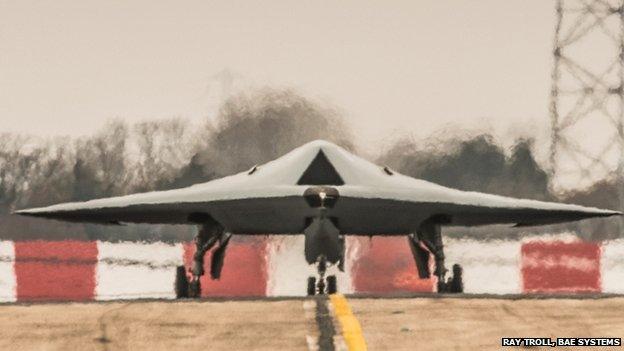Top secret UK drone Taranis makes first flight
- Published

Taranis - named after the Celtic god of thunder - is said to be the most advanced aircraft ever built in the UK
A top secret unmanned drone, said to be the most advanced aircraft ever built in Britain, has carried out its first successful test flights.
It looks like something out of a science fiction movie. But it is also a window into the future of warfare.
Some will view it as an amazing piece of engineering. But not everyone will like what they see.
Taranis - named after the Celtic god of thunder - was first unveiled BAE Systems in 2010.
It was a glitzy ceremony in an aircraft hangar, with moody music and flashing lights. Rather odd given that it is supposed to be a "classified" or top secret programme, partly funded by the Ministry of Defence.
But over the past few years there has been no publicity surrounding its development.
The release of new imagery breaks the strict "radio silence".
Nigel Whitehouse, of BAE Systems, calls Taranis the "pinnacle of British engineering".
It is the most advanced drone ever developed in the UK.
And it has now successfully test flown at an unnamed location, believed to be in the Australian desert in August last year, the MoD has revealed.

Taranis made its first flight in August last year
Away from prying eyes, and other aircraft, it conducted an unspecified number of flights that each lasted up to an hour, at a variety of speeds and altitudes.
Beyond that there's little information about the project.
Test pilot Bob Fraser said everything went according to plan. But if you ask him how high or fast it flew he is not allowed to give a precise answer.
He will only say Taranis flew at least "twice as fast" as any other drone he has operated from the ground.
Eventually it is supposed to fly faster than the speed of sound.
What we do know is that Taranis is the prototype for Britain's first stealth combat drone.
It is low profile and acute angles are not just designed for speed, but also to avoid detection by radar.
The goal here is to develop an unmanned plane that that can fly into "contested airspace" and deliver its weapons deep behind enemy lines.
The obvious attraction to any politician is that if the technology proves effective such strikes could be carried out without endangering the lives of a pilot or aircrew.
BAE's Nigel Whitehead said: "The first flight of Taranis represents a major landmark for UK aviation. The demonstrator is the most advanced air system ever conceived, designed and built in the UK.
"It truly represents an evolution of everything that has come before it."
BAE's Nigel Whitehead says in a "difficult, dirty and dangerous environment it'll be irresistible to future military planners".
That is the theory. But there's still a long way to go. So far the programme has cost a modest £185m, shared by industry and the MoD.
Taranis was designed and built by BAE Systems, Rolls-Royce, GE Aviation and QinetiQ, with its engineers working alongside MoD military staff and scientists
Developing it into a real warplane will be much more expensive.
The United States and China are among the few other countries that have similar programmes. Britain is already looking to cooperate with France in a bid to share the costs of developing its Remotely Piloted Air Systems (RPAS).
Defence Procurement Minister Philip Dunne says Taranis will provide the building blocks for the future as a "technology demonstrator programme".
While the MoD and industry have lifted the curtain on its drone development programme, there are still plenty of questions. As well as the issues of safety there are concerns about the legal and moral case for their use.

Taranis was first unveiled BAE Systems in 2010
General Stanley McChrystal, the former head of Nato troops in Afghanistan, recently warned of the dangers of viewing drone strikes as the "easy option".
He said there was "a perception of arrogance as helpless people are being shot at like thunderbolts from the sky".
Perhaps the name Taranis - Celtic god of thunder - is unfortunate in this context.
It is also why the RAF and MoD are anxious to stress that there is always a human in control.
In fact, drone is a word they avoid.
But Taranis can also be flown "autonomously" as in without a pilot.
Air Vice Marshall Sue Grey, the director of the RAF's Combat Air, admits the aircraft is capable of flying itself but she stresses there "will always be a man in the loop".
For the RAF the term "drone" is a misnomer. But "killer robot" would be even worse.
- Published12 July 2010
- Published5 February 2014
- Published30 December 2013